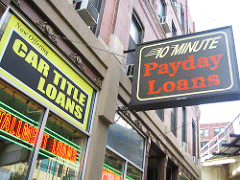
Payday loans are usually for a few hundred dollars and typically cover emergency expenses such as medical or auto repair costs. They are typically due upon the borrower’s next paycheck. The difficulty is that borrowers often cannot repay the entire amount when their next paycheck arrives and thus must borrow more, racking up high fees. The CFPB documents that 75 percent of all payday loan fees are from borrowers who take out more than 10 loans a year. In addition to payday loans, the CFPB proposal covers other small-dollar loans such as car title and high-cost installment loans. These loans are also traps: 80 percent of all car title loan revenue comes from borrowers taking out more than 7 loans a year.
The CFPB proposes a sensible ability-to-repay test for small-dollar loans. This is a large step in the right direction. However, advocates have concerns over loopholes that will exempt categories of loans from the ability-to-repay test. Also, advocates seek to ensure that the final CFPB rule does not outlaw strong protections and rate caps that have been instituted by 14 states and the District of Columbia.
While necessary, a rigorous CFPB final rule will not be sufficient in ensuring that minority- and lower-income consumers have access to affordable small-dollar loans. The approach must be two-pronged: it must prohibit exploitative practices but also encourage traditional banks to make more of an effort in providing responsible credit to underserved populations, and this is where the Community Reinvestment Act (CRA) comes into play. Enforced by three federal agencies (the Federal Reserve Board, the Federal Deposit Insurance Corporation, and the Office of the Comptroller of the Currency), CRA exams assess and rate banks’ records in providing loans, investments, and services to low- and moderate-income consumers and communities. CRA, however, has usually focused on home and small business lending. There is passing attention paid to small dollar consumer lending but the regulators can and must do a better job of encouraging the banks to make more responsible small-dollar loans to consumers, especially those seeking credit to cover emergency situations.
In response to the CFPB’s request for comment, I joined with my NCRC colleagues Gerron Levi and Mike Carrah in developing CRA recommendations sent to the CFPB. The letter encouraged the CFPB to work with the bank regulatory agencies to motivate banks to increase responsible small-dollar loans to consumers.
First, the CFPB and the federal bank agencies should write an interagency memo that explains the contours of the final CFPB rule and encourages banks to make responsible small-dollar consumer loans. Bank agencies recently revised a interagency guidance document (called a Question and Answer document) and affirmed the importance of banks making small-dollar consumer loans and offering financial education. The bank agencies and CFPB are thus poised to combine efforts and develop more interagency guidance to the banks.
Second, the CFPB and the bank agencies must collaborate to develop improved performance context analysis for CRA exams. Performance context is designed to inform an analysis of credit needs on exams by reviewing economic and demographic conditions. The performance context analysis on exams currently does not identify needs for small-dollar consumer loans. The first step for improved performance context analysis is to conduct analysis showing geographical areas (counties or portions of counties) experiencing concentrations of payday or other fringe outlets or loans. Then the CRA exam can assess whether banks are competing against the payday and high-cost lenders in these areas and responding to the needs for small-dollar consumer lending.
Third, CRA exams do not currently examine consumer lending unless this lending constitutes a substantial majority of a bank’s loans. This must be changed to require examination of consumer lending when such lending is a significant component of a bank’s product offering. The exam needs to ensure that the lending is responsible and that low- and moderate-income borrowers are indeed receiving responsible loans. Currently a number of banks offer credit card loans and responsible credit card loans do not pose the same debt traps as high-cost payday loans. Yet, an examination of credit card lending on CRA exams is the exception, not the rule. At the same time, CRA exams must continue examining home and small business lending for banks that offer credit card loans since home and small business lending offer more opportunities to build wealth than consumer or credit card lending.
CRA exams cannot compel banks to make consumer loans. In cases in which banks are not involved in this type of lending, they can still be assessed regarding how they are responding to the need for consumer lending and responsible management of credit by consumers. These banks can support financial education efforts, which is an activity scrutinized by CRA exams.
Financial institutions must be pulled away from making exploitative consumer loans by a strong CFPB rule. Via CRA, institutions must also be encouraged to make responsible consumer loans or promote demand for responsible loans from educated consumers. A credit-starved community must be shielded from poisonous and ruinous credit and also have opportunities to secure responsible credit that will help to build wealth.
(Photo credit: Amanda, via flickr, CC BY-NC-ND 2.0)






Comments